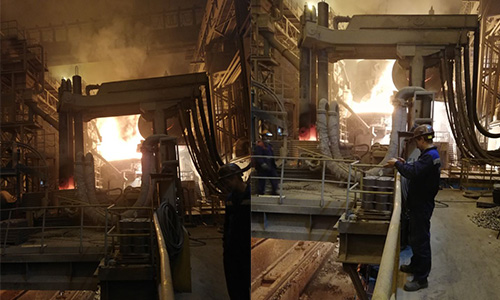Electric Arc Furnace Wall Refractories
Electric arc furnace lining mainly includes furnace cover, furnace wall and furnace bottom, most often used furnace lining is alkaline furnace lining. Alkaline electric arc furnace lining refractories should have these properties.
Enough refractoriness and refractoriness under load, because at the action of electric arc, electric arc furnace lining temperature can reach to 1500~1800℃.
Should have strong slag resistance, as furnace slag, fume and dusts can penetrate into lining through gaps and pores at high temperature, which can cause the molten damage of refractories and lead to spalling.
Good thermal shock resistance. As during steel smelting, opening furnace door and lifting furnace cover can cause rapid temperature change, furnace may have stripping or cracking.
Should have enough strength, as furnace lining suffers impact during charging, vibration during tilting, metal, molten slag and air washing during iron liquid boiling.
Low Thermal Conductivity and Low Electric Conductivity.
Usually used electric arc furnace refractories are magnesite bricks, dolomite bricks, high alumina bricks, silica bricks, calcined magnesite stamped mix and so on. As the working condition of different parts varies far, corresponding refractory materials should be selected.
Electric Arc Furnace Wall Refractories
Electric arc furnace wall suffers high temperature action and drastic temperature change affection, besides, it also suffers steel liquid and molten slag chemical corrosion, furnace feed collision, so furnace wall lining refractories should have enough strength, good corrosion resistance, excellent thermal shock resistance and thermal conductivity.
Electric arc furnace walls are classified into 3 types: firebrick lined furnace wall, magnesite blocks lined furnace wall and integrally ramming furnace wall. Firebricks lined furnace wall has the same structure with furnace bottom, insulating layer is consisted of 10~15mm thick asbestos and 1 layer lightweight fireclay bricks or clay bricks.
Furnace wall lined by large magnesite blocks is pre-rammed by detachable steel plate mould, the whole furnace wall is consisted of 3~4 large blocks. Magnesite formulation, binder quantity and ramming craft is the same as bottom ramming layer.
Integrally rammed furnace wall is the most popular structure, when furnace bottom is rammed, circular mould is placed on it, and furnace wall is rammed layer by layer.
Electric furnace walls are usually lined by basic refractory bricks, mainly including magnesia chrome bricks, magnesia bricks, magnesite carbon bricks, dolomite bricks and so on. Ordinary electric furnace walls mainly adopts magnesia bricks, dolomite bricks and periclase bricks. Ultra high power electric arc furnace wall and special steel smelting electric furnaces have harsher working environment, so magnesia chrome bricks or premium magnesia bricks should be adopted.
In some countries, electric arc furnaces are usually lined by unburned magnesia chrome bricks, direct bonded or rebonded magnesia chrome bricks, fused magnesia chrome bricks, impregnated burned magnesite bricks, magnesia carbon bricks and so on. Periclase bricks, tar bonded dolomite bricks or pitch impregnated burned dolomite bricks are also used in some countries.
Electric arc furnace slag line zone and hot point are the most vulnerable parts of furnace wall, so magnesia carbon bricks are universally used, or water cooling furnace wall and hot gunning patching can be used to make furnace wall have similar damage rate, the service life is doubled. Magnesia carbon bricks have excellent high temperature performance, corrosion resistance is 0.5~2.0 times higher than direct bonded bricks, their thermal shock resistance and thermal conductivity is also good, but they are easy to be oxidized, some measures should be took during using.


